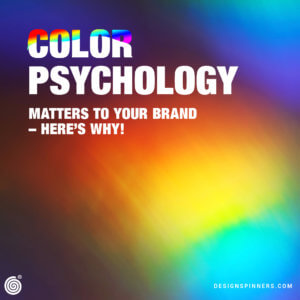 95% of businesses use only one or two colors in their logos. Using only one or two colors means you need to have the right one or two colors chosen, so you stand out from the crowd and grab your audience’s attention. Color is the first thing your customer will notice about your logo, so you need to make it count. Why does color matter so much? Color can evoke specific emotions from people, and you can use that power in your branding.
95% of businesses use only one or two colors in their logos. Using only one or two colors means you need to have the right one or two colors chosen, so you stand out from the crowd and grab your audience’s attention. Color is the first thing your customer will notice about your logo, so you need to make it count. Why does color matter so much? Color can evoke specific emotions from people, and you can use that power in your branding.
Why is color psychology important?
The right color can make you stand out from the crowd or blend into it. Poor color choice can do damage to your brand and image. If you have the wrong colors for your content or logo, it could come across as unreadable or challenging for your audience to understand. What colors are companies using the most? A study of the world’s top 100 brands analyzed each of their logos. Of those 100 brands, 29% used red, 33% used blue, 28% used black or grayscale, and 13% used yellow or gold. Your color choice can also influence how people think and behave towards your brand. Think about plant-based products almost always being packaged in green or cleaning products packaged in white. Our culture associates green with nature and white with cleanliness. Restaurants will use reds and oranges in their branding because studies have shown that those colors make people hungry.
What does each color mean?
Every color has a different meaning and will incite different feelings and emotions. Red is a more passionate color; it will increase your heart rate and illicit and more visceral response.
Blue is one of the most popular color choices as it is said to calm people and put them at ease.
Purple is a mysterious color and is associated with royalty and sophistication. Green is associated with freshness and health. With so many shades of green, it is the most versatile color when it comes to bringing out emotions. Yellow will make people feel bright and cheery. It also gives off creative energy, but too much yellow can be harsh on the eyes. Orange has the cheerfulness of yellow with the passion of red. It’s eye-catching and bold. However, it doesn’t grab attention like the color red, but it does add fun to your content. Brown is simple, strong, and neutral. It gives off a warm and honest vibe, but too much can make content or logos look muddy and hard to read. Black is classic and sophisticated. It can evoke many different emotions like sadness and anger, but also power. White is associated with purity, like a wedding dress, and cleanliness, like a doctor’s coat. It also helps create contrast among other colors.
Is color psychology the same everywhere?
Color psychology is different all around the world. Some color associations, like red, green, and brown, can be explained by looking at where they appear in nature and what they meant for early humans. Some color association comes from culture, not nature. If your brand is worldwide, you will need to think about other cultures and how they perceive color. For example, in China and India, the color white is associated with death and worn to funerals, but in the US, black is worn. Yellow is a fun, happy color in the US, but it’s one of courage in Japan. In the 18th century, green stood for poison, but now it stands for nature and growth, showing that a color’s meaning can also change over time.
How do you know which color is best for you?
Just because your favorite color is yellow doesn’t mean you should brand your business with that color. Your color needs to fit your brand and content’s personality. Start by asking yourself these questions to get an idea of what colors you should use for your brand.
- Gender: Is your brand traditionally masculine or feminine?
- Tone: Is your brand playful or serious?
- Value: Is your brand more luxurious or affordable?
- Time: Is your brand classic or more modern?
- Age: Is your audience younger or more mature?
- Energy: Does your brand have a lot of energy, or is it more subdued?
Those answers will set you on the right track to choosing your colors to show off your brand’s personality. You also need to think about your industry colors. Industries tend to lean towards the same color schemes. Tech industries go with blue, restaurants are red, yellow, and orange, agriculture tends to be green, healthcare is white, and retail is red.
Color is a powerful tool and can influence thinking and reactions and hold various meanings to individuals. Make sure that you align your colors with your brand and content to convey a clear and concise message that will draw in your audience. Contact Design Spinners if you want help developing your branding, including your colors, logo design, and anything else your business needs!
Sources:
https://justcreative.com/color-psychology-in-logo-design-branding-explained/
https://www.oberlo.com/blog/color-psychology-color-meanings
https://99designs.com/blog/tips/color-psychology/
https://99designs.com/logo-design/psychology-of-color
